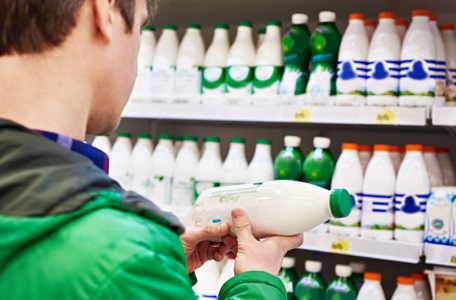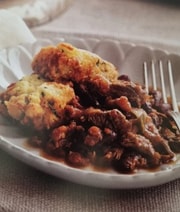Aussies face skyrocketing prices for essential staples
By
Gian T
- Replies 20
If you’ve been feeling the pinch at the checkout lately, brace yourself—because things might be about to get even tighter.
Aussies are being warned to prepare for a fresh 'bill explosion' that could see the prices of everyday essentials like milk, butter, meat, and even electricity soar in the coming months.
For many of us, these aren’t just luxuries—they’re staples that keep the fridge full and the lights on.
It’s a perfect storm of factors, with Mother Nature leading the charge.
Recent floods on the NSW mid-north coast, particularly around Taree, Wingham, and Gloucester, have devastated dairy herds.
Add to that the lingering effects of drought and the impact of Cyclone Alfred in Queensland, and you’ve got a recipe for disaster for our farmers—and, by extension, for our wallets.
Joe Bradley, president of dairy farmers’ group eastAUSmilk, says the situation is dire: 'We estimate that between the drought, the floods, and Cyclone Alfred, about 80 per cent of dairy farmers have been affected one way or another.'
The result is a likely 10 per cent drop in Australian milk production, which could push the price of a litre of milk from $1.55 to over $2.
'Milk has to go up: you can’t be paying $1.50 a litre for milk, it has to be two bucks a litre minimum for home brand milk,' Bradley warned.
It’s not just milk. Butter prices are also set to rise, with Australia now importing more butter than ever before.
Global issues—like blue tongue disease affecting European cattle—are pushing up international butter prices, and those costs are being passed on to us.
Michael Harvey, a senior dairy analyst with Rabobank, says, 'It’s a record-high butter price at the moment. If it remains elevated, you’ll see retail prices moving higher.'
Eggs have already seen an 18.6 per cent price jump in the past year, thanks to avian influenza outbreaks in Victoria and NSW.
Supermarkets have even had to limit customers to two cartons each, with empty shelves becoming a common sight.
And it doesn’t stop there. Beef and lamb prices are also tipped to rise in the next six months as drought conditions in southern Australia reduce livestock supply.
According to agribusiness giant Elders, 'increased de-stocking in dry regions' means less meat on the market and higher prices for consumers.
It’s sobering to realise that Australia’s dairy industry is a shadow of its former self.
In 2001, we produced 11.3 billion litres of milk annually. Now, despite a much larger population, that figure has dropped to just 8.2 billion litres.
The number of dairy farmers in NSW and Queensland has plunged by 85 per cent over the past two decades.
Once a farm leaves the industry, it rarely returns—meaning less local milk and more reliance on imports.
As Bradley puts it, 'If milk keeps getting shorter, dairy products keep getting shorter, it might not be a staple diet anymore—it might be a luxury diet.'
As if rising grocery bills weren’t enough, electricity prices are also on the up.
From 1 July, customers on default market offers can expect increases of between 0.5 per cent and 9.7 per cent, depending on where you live.
NSW customers face the steepest hikes, while those in Queensland, South Australia, and Victoria will also see their bills rise—albeit by slightly less.
The government says the transition to renewables is the cheapest way forward in the long run, but for now, many households are feeling the squeeze.
Prime Minister Anthony Albanese insists, 'The cheapest form of new energy is renewables, backed by gas, batteries, and hydro for firming capacity.'
However, the opposition argues that prices are still rising, with high demand, network outages, and low renewable energy generation all contributing to the issue.
With headline inflation rising by 2.4 per cent in the year to April but fruit and vegetable prices jumping by 6.1 per cent, it’s clear that the cost of living is still a significant concern for many Australians—especially those on fixed incomes.
To manage rising costs, shop smart by seeking specials, buying in bulk, and trying home brands.
Support local farmers’ markets for fresher, often cheaper produce.
Reduce waste by planning meals and using leftovers creatively.
Review your energy plan to find better deals, and don’t hesitate to reach out to utility providers or community groups for support if needed.
Last week, Aussies have been warned of a possible milk shortage and rising prices after severe floods hit northern NSW.
Dairy farmers faced enormous losses, with whole herds lost and millions of dollars in damage to property and equipment. You can read more about it here.
 Are you already feeling the impact of rising prices at the supermarket or on your power bill? Have you changed your shopping habits, or are you worried about what’s to come? We’d love to hear your thoughts and tips—share your experiences in the comments below.
Are you already feeling the impact of rising prices at the supermarket or on your power bill? Have you changed your shopping habits, or are you worried about what’s to come? We’d love to hear your thoughts and tips—share your experiences in the comments below.
Aussies are being warned to prepare for a fresh 'bill explosion' that could see the prices of everyday essentials like milk, butter, meat, and even electricity soar in the coming months.
For many of us, these aren’t just luxuries—they’re staples that keep the fridge full and the lights on.
It’s a perfect storm of factors, with Mother Nature leading the charge.
Recent floods on the NSW mid-north coast, particularly around Taree, Wingham, and Gloucester, have devastated dairy herds.
Add to that the lingering effects of drought and the impact of Cyclone Alfred in Queensland, and you’ve got a recipe for disaster for our farmers—and, by extension, for our wallets.
Joe Bradley, president of dairy farmers’ group eastAUSmilk, says the situation is dire: 'We estimate that between the drought, the floods, and Cyclone Alfred, about 80 per cent of dairy farmers have been affected one way or another.'
The result is a likely 10 per cent drop in Australian milk production, which could push the price of a litre of milk from $1.55 to over $2.
'Milk has to go up: you can’t be paying $1.50 a litre for milk, it has to be two bucks a litre minimum for home brand milk,' Bradley warned.
It’s not just milk. Butter prices are also set to rise, with Australia now importing more butter than ever before.
Global issues—like blue tongue disease affecting European cattle—are pushing up international butter prices, and those costs are being passed on to us.
Michael Harvey, a senior dairy analyst with Rabobank, says, 'It’s a record-high butter price at the moment. If it remains elevated, you’ll see retail prices moving higher.'
Eggs have already seen an 18.6 per cent price jump in the past year, thanks to avian influenza outbreaks in Victoria and NSW.
Supermarkets have even had to limit customers to two cartons each, with empty shelves becoming a common sight.
And it doesn’t stop there. Beef and lamb prices are also tipped to rise in the next six months as drought conditions in southern Australia reduce livestock supply.
According to agribusiness giant Elders, 'increased de-stocking in dry regions' means less meat on the market and higher prices for consumers.
It’s sobering to realise that Australia’s dairy industry is a shadow of its former self.
In 2001, we produced 11.3 billion litres of milk annually. Now, despite a much larger population, that figure has dropped to just 8.2 billion litres.
The number of dairy farmers in NSW and Queensland has plunged by 85 per cent over the past two decades.
Once a farm leaves the industry, it rarely returns—meaning less local milk and more reliance on imports.
As Bradley puts it, 'If milk keeps getting shorter, dairy products keep getting shorter, it might not be a staple diet anymore—it might be a luxury diet.'
As if rising grocery bills weren’t enough, electricity prices are also on the up.
From 1 July, customers on default market offers can expect increases of between 0.5 per cent and 9.7 per cent, depending on where you live.
NSW customers face the steepest hikes, while those in Queensland, South Australia, and Victoria will also see their bills rise—albeit by slightly less.
The government says the transition to renewables is the cheapest way forward in the long run, but for now, many households are feeling the squeeze.
Prime Minister Anthony Albanese insists, 'The cheapest form of new energy is renewables, backed by gas, batteries, and hydro for firming capacity.'
However, the opposition argues that prices are still rising, with high demand, network outages, and low renewable energy generation all contributing to the issue.
With headline inflation rising by 2.4 per cent in the year to April but fruit and vegetable prices jumping by 6.1 per cent, it’s clear that the cost of living is still a significant concern for many Australians—especially those on fixed incomes.
To manage rising costs, shop smart by seeking specials, buying in bulk, and trying home brands.
Support local farmers’ markets for fresher, often cheaper produce.
Reduce waste by planning meals and using leftovers creatively.
Review your energy plan to find better deals, and don’t hesitate to reach out to utility providers or community groups for support if needed.
Last week, Aussies have been warned of a possible milk shortage and rising prices after severe floods hit northern NSW.
Dairy farmers faced enormous losses, with whole herds lost and millions of dollars in damage to property and equipment. You can read more about it here.
Key Takeaways
- Australians are being warned of significant price increases for milk, butter, meat, and electricity due to recent floods, droughts, and global supply issues.
- Dairy production has dropped sharply, with milk output expected to fall by 10 per cent and the number of dairy farmers in NSW and Queensland declining by 85 per cent over the past two decades.
- Egg prices have already jumped 18.6 per cent in the past year due to avian influenza, and analysts predict further rises in beef, lamb, and butter prices.
- Power bills are set to rise nationally from July, with the steepest increases expected for NSW customers, adding further pressure to the cost of living.









